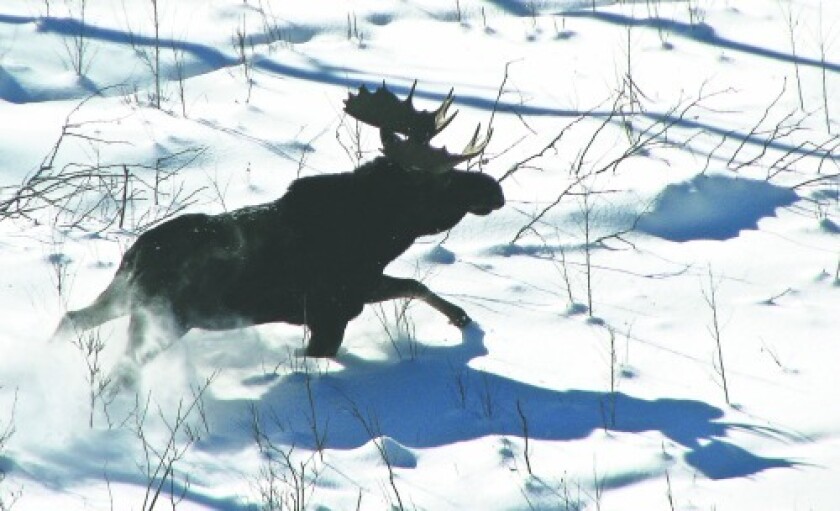DULUTH — Northeastern Minnesota's moose herd continues to hang on, up a tick over last year but still just a fraction of the modern high population of 20 years ago.
That was the report issued Monday by the Minnesota Department of Natural Resources after the agency’s annual winter moose aerial survey.
ADVERTISEMENT
The survey estimated 3,470 moose across the core range — essentially Lake, Cook and northern St. Louis counties — which is up 5% from 3,290 in 2023 but still down from 4,700 in 2022.
Each January, wildlife biologists from the DNR and tribal resource agencies fly over parts of the state's moose range in helicopters to count moose in specific zones. They then extrapolate their findings over the entire moose range to get the overall estimate.
Surveyors faced an unusual problem this year of not having enough snow on the ground. The survey usually waits until there is at least 8 inches of snow cover to make the dark moose show up better against a white backdrop, but less than a fourth of the area surveyed had that much snow this year, the DNR reported. Still, researchers said there was enough snow to make the survey comparable to other years.
Northeastern Minnesota's moose numbers crashed rapidly 15 years ago, from a modern high of 8,840 moose estimated in 2006 to just 2,700 by 2013. Their numbers have remained low but fairly stable, with annual fluctuations but no major trend, for the past decade.
“While estimates suggest continued stability in the population and reproductive success ... Minnesota moose remain at risk given the long-term trends,’’ the agency noted in releasing the report.
The agency cautions that the high variability of the study and changing conditions means the report should be used to monitor long-term trends with less focus on annual ups and downs. This year’s estimate of 3,470 is a mid-range between the low range of 2,570 and the possible high range of 4,940 in the survey estimate.

It's never been entirely clear why Northeastern Minnesota's moose numbers crashed so fast and hard. It followed the nearly complete elimination of northwestern Minnesota's moose herd in the 1990s. Scientists believe myriad factors, including a warming climate, are involved. Warmer winters with less snow allow more deer to move north, bringing along a brainworm parasite fatal to moose.
ADVERTISEMENT
It's possible a recent string of snowy winters in Northeastern Minnesota, six of the last 10, have helped push deer numbers back down and allowed moose to thrive, although this winter has been historically mild, which should allow deer to begin a rebound. Moose also aren't suited to handle warmer summer temperatures.
Habitat is also an issue, with moose continuing to thrive in areas where major wildfires burned in recent years, where younger forests have sprouted, but not as much in areas where forests have matured.
Efforts are underway using a major federal grant to develop large-scale logging and/or intentional fires in prime moose areas of the Arrowhead, turning over tens of thousands of acres of older forest into the younger forests that moose need to thrive. County, state and Forest Service forests are involved along with wildlife biologists from the DNR and tribes and several conservation organizations.
A thriving wolf population also plays a role in the moose decline, especially after moose numbers initially crashed, with wolves focusing on the calves that are needed to rebuild the moose population annually. Because wolves thrive most on deer, northern Minnesota has among the highest wolf densities anywhere the big canines roam in North America, which is not good news for newborn moose calves. It remains unclear if or when the state will regain control of wolves, which are now protected by federal law.
This year’s survey found that 17% of cows had calves with them. That number has ranged from just 12% in the lowest years to as high as 19%.
Both the Fond du Lac Band of Lake Superior Chippewa and the 1854 Treaty Authority contributed funding and personnel for the 2024 annual survey. The survey is available on the Minnesota DNR’s moose management webpage at











